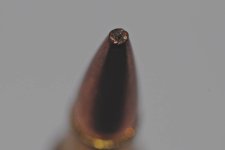N80
Super Member
This is a 7mm-08, Remington case. Bullet type is unmarked and unknown. I do not think it is a reload so probably something standard from Remington but it is different in appearance from all the other Soft Point Cor-Lokt bullets I have. The main thing I want to know is if it is a big game bullet suitable for deer. Any assistance appreciated.

P.S.: I have tried using Remington's web site but it is, and has always been, almost unusably slow. I have no idea why......probably big brother....

P.S.: I have tried using Remington's web site but it is, and has always been, almost unusably slow. I have no idea why......probably big brother....